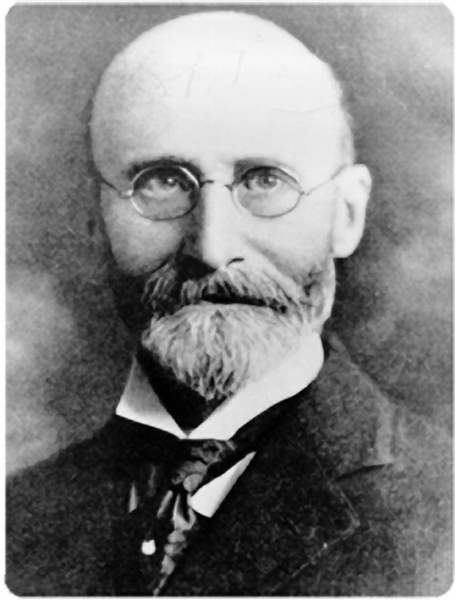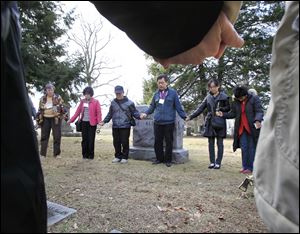
Korean group honors Toledoan credited with starting church
2/19/2011
Allen

The Rev. Koo Jong Mo, a Seoul pastor, leads prayer at Dr. Horace Newton Allen’s grave in Woodlawn Cemetery.
It was a solemn moment for the delegation from Seoul, who had traveled more than 6,600 miles to pay tribute to Dr. Horace Newton Allen, a physician and missionary who, more than a century ago, was instrumental in bringing Christianity, modern medicine, and industry to their homeland.
Mr. Koo said Dr. Allen, a native of Delaware, Ohio, who spent the last 27 years of his life in Toledo, founded Namdaemoon Church in 1887, when Westerners and Koreans began attending church services in the doctor's home. Namdaemoon means Southgate in English.
Dr. Allen also founded Yonsei University and Severance Medical Hospital and Medical School in Seoul, and spent 15 years in diplomatic service in Washington and Korea. "Dr. Allen played a very, very important role in spreading Christianity in Korea," said Lee John Yeon, 80, an attorney and a deacon at the Korean church.
He was able to play such a role because "he was so lucky," Mr. Lee said.
"He was so blessed," said Ko Kyung-ryang, correcting him.
Whether by chance or divine providence, Dr. Allen was given an extraordinary opportunity just months after he and his wife, Frances, arrived in Seoul on Sept. 20, 1884.
Japan, China, and Russia had been fighting for control of the Korean peninsula, and Japanese rebels attempted to assassinate Korea's Prince Min Yong Ik, gravely wounding him by stabbing him nine times.
Korean doctors, untrained in modern medical techniques, were about to fill the prince's wounds with melted wax when a German diplomat halted them and summoned Dr. Allen. The Ohio physician was able to stitch up the prince and oversee his three-month recovery, earning the profound gratitude of King Gojong of Korea.
Dr. Allen's favor with the royal family enabled him to start a university and a teaching hospital, funded with a $43,000 donation from Cleveland philanthropist Louis Henry Severance. Today, the university has 28,000 students and an annual budget of $2.7 billion.
As the first Protestant missionary to Korea, Dr. Allen used his medical practice to "disguise" his efforts to spread the Gospel, Mr. Lee said.
It was strictly forbidden to proselytize in the country, whose religious makeup in the late 1800s consisted of Confucianism, Buddhism, and Shamanism.
More than 10,000 converts to Christianity, including a number of Catholic missionaries who came before Dr. Allen, had been executed — many beheaded — for preaching the Gospel, Mr. Lee said.
Ms. Ko, who is studying for a doctorate in theology in Seoul, said Dr. Allen was criticized by some missionaries for not speaking openly about Jesus. Some missionaries also complained to Dr. Allen that he was becoming too politically involved, but the same critics were quick to call on the doctor for help when they ran into trouble or obstacles.
"He did not evangelize directly," Ms. Ko said, but preferred to let his actions testify to his faith.
"He was a ‘good Samaritan,'" she said. "He believed a good deed, good behavior, considerate behavior came first before preaching the Gospel."
Mr. Lee said Dr. Allen's medical training gave him the ability to take a realistic look at Korea and assess the country's needs. "He saw things as they are. He saw what Korea needed, and what was the best way to spread the Gospel," he said.
That included serving as a U.S. diplomat to Korea and also making arrangements to partner with American businesses to introduce the telegraph and to develop mining, railroads, electricity, and public water systems in Korea.
The Korean delegation that is visiting Ohio was invited by First Presbyterian Church of Delaware, Dr. Allen's former church, which is celebrating its 200th anniversary. The group arrived in Delaware, which is about 20 miles north of Columbus, on Monday and will depart for Seoul on Monday.
Their six-hour tour of Toledo began with a visit to First Congregational Church in Toledo's Old West End, where Dr. Allen had been a member. Church records show that Dr. Allen's membership was "dismissed" in 1914, but no explanation is available, said the Rev. Larry Vrielezaar, pastor.
It is one of a number of mysteries surrounding Dr. Allen.
Nobody knows why he joined a Congregational church after retiring in Toledo in 1905, having been a Presbyterian all his life.
It is also unclear why he chose to move to Toledo, although it may have been because his sister, Jennie Allen Everett, lived here.
The Korean group had planned to take a bus ride past Dr. Allen's former home at 2248 Parkwood Ave., just around the corner from First Congregational, but the street was closed for road construction.
More disappointing than not seeing Dr. Allen's home was not getting to meet the missionary doctor's descendants who live in the Toledo area.
One of his great-grandaughters, Maxine Allen, said afterward that she had driven to First Congregational Church to meet the visitors in the morning, but because of some unexplained mix-up was unable to find the Koreans.
Another great-grandaughter, Lydia Allen, who lives near Grand Rapids, Ohio, told The Blade that she did not want to participate.
She said she believes Dr. Allen did not actually found Namdaemoon Church and suspects the Koreans are trying to rewrite history to exploit Dr. Allen's stature in their home country.

Allen
But Mr. Lee countered that "there is no doubt" Dr. Allen founded the church.
The doctor provided a place in his home for hospital employees to gather for worship, and ordained Presbyterian ministers he hired at the hospital performed baptisms and weddings and other church rituals in Dr. Allen's house.
Although Namdaemoon was not officially chartered as a church until years later, the hospital and house church were "inseparable" from the start, Mr. Lee and Mr. Koo said.
Barbara Tull, a member of First Presbyterian of Delaware, said the Korean visitors were "terribly disappointed" at not getting to meet Dr. Allen's descendants in person.
After their prayers at the Allen graveside, the group had lunch at Koreana Restaurant on Reynolds Road before heading back to Delaware.
"Americans have little, if any, knowledge of Dr. Allen, one of Ohio's most distinguished citizens, but everywhere you go in Seoul you see plaques honoring him," said Kris Jones of Delaware, who helped plan the Koreans' visit.
Song Boseok, 17, described Dr. Allen as a "very important" figure to Korean Christians.
"Without him, we are not here," he said.
Contact David Yonke at: dyonke@theblade.com or 419-724-6154.
Dr. Horace Newton Allen timeline
-Born in Delaware, Ohio, to Horace and Jane (Riley) Allen on April 23, 1858.
-Married Frances Ann Messenger, a fellow Ohio Wesleyan graduate, in 1881.
-Dr. Allen was sent as a Presbyterian missionary to Nanking and Shanghai, China, in 1883, the same year he graduated from Miami Medical College at Cincinnati.
-In 1884, he became the first Protestant missionary to Korea.
-Dr. Allen founded Jejungwon (hospital), now Yonsei University and Severance Medical School, in 1886 and started a house church in 1887.
-He brought 12 Korean nationals to Washington in 1888, establishing a Korean legation.
-He published the first of four books, Korean Tales, in 1889.
-Dr. Allen was appointed secretary to the American legation in Korea in 1890 and was charge d'affaires from 1893 to 1894.
-In 1897, President William McKinley promoted him to minister resident and consul general to Korea.
-He was named envoy-extraordinary and minister-plenipotentiary to the Korean court in 1901.
-In 1905, Dr. Allen was fired by President Theodore Roosevelt for opposing U.S. policy on Korea, which favored Japanese rule of Korea. He moved to Toledo in retirement.
-Dr. Allen died in his home on Parkwood Avenue in Toledo's Old West End on Dec. 11, 1932, at age 74.
-In 1974, his collected writings were donated to the New York Public Library.